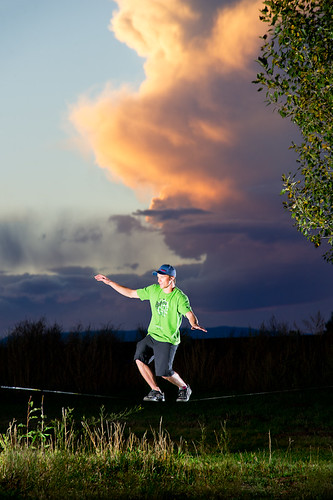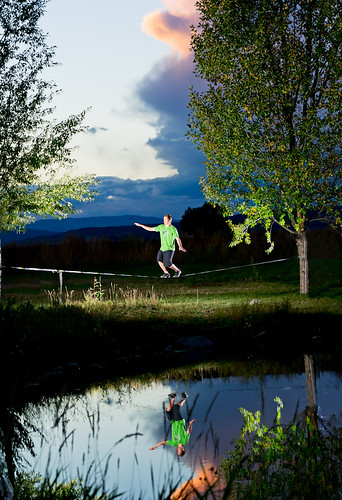Basic slack lining takes a lot of balance, strength, and determination to learn. It's a lot of fun, but doesn't appear to be too exciting (photographically at least). For my shoot last night, I decided to try and capture it in a more artistic and dynamic way. My goal was to make the athlete look like a model on the slack line. It was tough to accomplish this, and the results aren't what I was intending for, but I ended up with some very cool shots by changing the approach part way through.
On any shoot you need to be ready for the unexpected. Luckily for me, I wasn't expecting much so no matter what I did it was unexpected! I planned on scouting and finding a good spot for the slack line to setup and to start shooting it by 5:30. This just wasn't happening. I finally had a spot at 5:45, and the athlete (Thanks a lot Matt.....haha) didn't show up until 6:15.... Here's my plan from the start: Shoot Matt on the slack line, and create a dynamic look to add some excitement to the image.
When he finally arrived, I set up my flashes one by one. Always build up your flashes, setting multiples up right away makes it tough to figure out what's missing, or isn't working. I placed a 60" umbrella over my main fill light, and no modification over my other two lights. This way, I could use the other lights as rim, or side lighting to make the edges stronger, and use the fill light up front for some soft even lighting.
I know that typically wide angle lenses make things look more dramatic. So I figured I would start out with my 14-24mm f/2.8 Nikkor and see what I can get. My approach was to make sure and capture the images that I know would work, and then look for some experimental angles once that was set. I wanted the pond in the background to add some scenery to the image, so I worked around that.
My bare flashes were set up to the left front, and right behind of the athlete to strengthen the edges and help separate him from the background. The modified flash was just to left and above me. I wanted it at the height of the athlete to help get rid of any shadows, and feathered up so as not to over contaminate the grass on the ground.
After shooting this until I had a shot that I knew would work, I decided to throw on the telephoto (This covers both extremes). I ran all around the scene, and quickly realized that we were having an amazing sunset. I knew I had to work that into the shot! I set up facing the amazing clouds and re-worked my lighting around it. This time I went with just the two bare flashes on opposite sides and towards me from the athlete. I knew it would light him well, and also accent the slack line to show that he's in the air. Not to mention it brightens up the grass and adds some light to the trees on both sides.
Unfortunately, the only way to get the trees in the shot and not show the flashes was to place them far enough back that they contaminated the trees a little. Nothing that a bit of editing can't fix but still an inconvenience. I zoomed both these flashes in fairly far to make sure they didn't catch the trees too much, and still lit Matt well.
Here's when the magic happened. I would call this a "happy accident", but in reality, if your looking for details as you shoot great things will happen all the time. Alway's be alert and looking for a better shot and it may just jump out at you. I noticed the reflection in the pond, and how vibrant the flash was making the colors. I had to work this into the shot!
I composed to include the reflection, athlete, and sunset. It took a lot of running around fast since light levels were dropping, but the results speak for themselves.
After about 30 minutes of shooting, and the sunset complete, I decided to take a lifestyle involving a reflection. I placed the umbrella flash across the outlet of the pond about 12 feet from the athlete, and added the other two flashes to the sides. Ideally, I would have liked to work this one out more, but the "alway's late" model was "already late" to his next appointment.
End of shoot.
Lesson(s) to be learned: Look for the small details and work quickly. If a shot is not working, move along and find something else. Capture the safe and easy shot first to guarantee you have a good image from the shoot, then look for all the details and let the magic happen!
That's the BUZZ for Today! Please check back soon for more.












0 comments:
Post a Comment